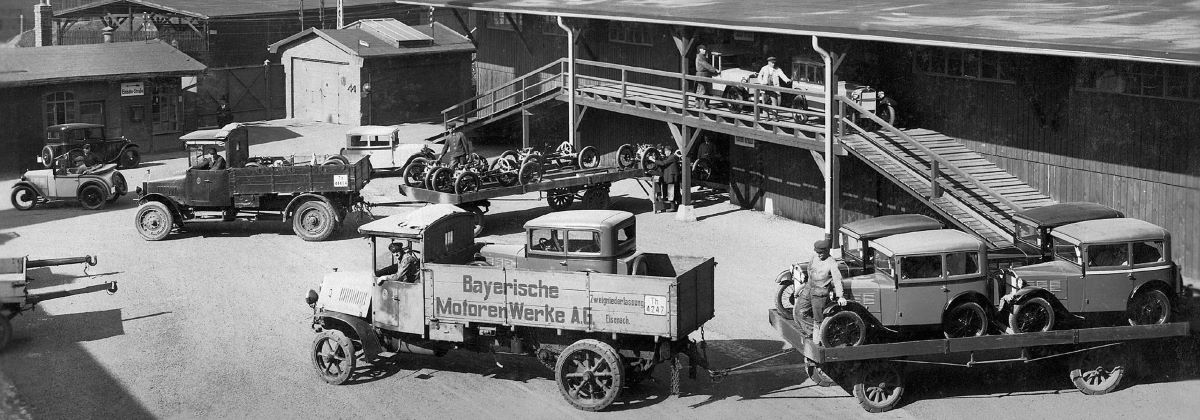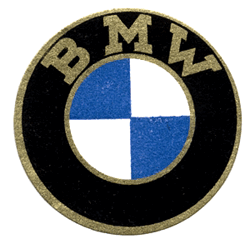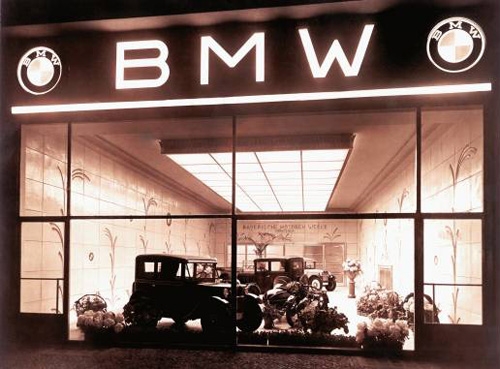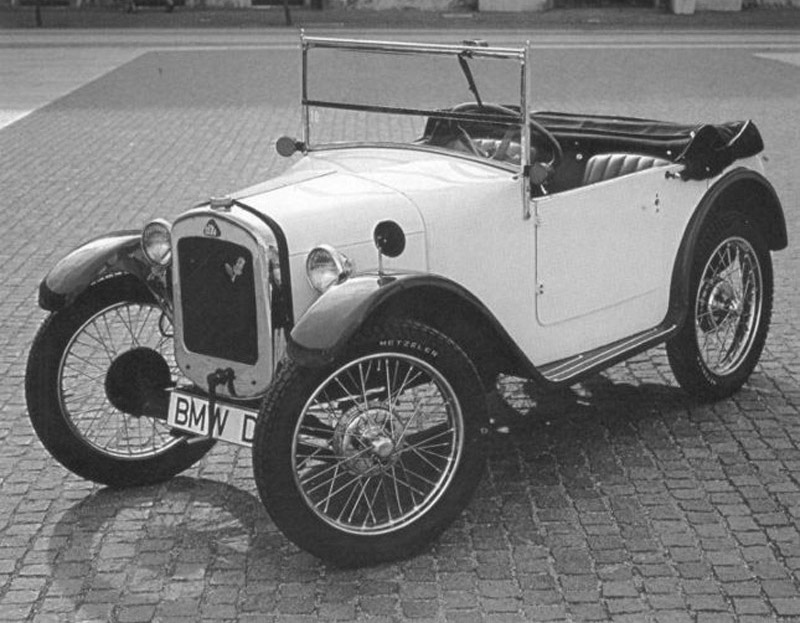
BMW became an automobile manufacturer in 1928 by purchasing the company known as Fahrzeugfabrik Eisenach. Until the Second World War broke out, all BMW cars were made at this plant in the Thuringia region of Germany. The first BMW small car was built under licence from the Austin Motor Company in 1929, but was superseded by the company’s own designs in 1932.
Bayerische Motoren Werke AG

Bayerische Motoren Werke AG, commonly abbreviated to BMW, is a German multinational manufacturer of luxury vehicles and motorcycles headquartered in Munich, Bavaria, Germany.
The BMW Group: a story of mobility.
“Bayerische Flugzeugwerke AG” (BFW) was established on 6 March 1916. In 1922, financier Camillo Castiglioni acquired engine production along with the workforce and production facilities, the company name and the logo in white and blue of “Bayerische Motoren Werke GmbH” and transferred all these assets to “Bayerische Flugzeugwerke AG”. Since that point, the establishment of BFW has been recorded as the birthday of Bayerische Motoren Werke.
BMW flying high: from the best aero-engine of its time to the first BMW motorcycle.
During the First World War, the company only manufactured one product: the aero-engine BMW Illa. The 6-cylinder inline engine had the reputation of being the best aero-engine of its time. Sports competitions played a big role for the company from an early stage. A BMW IV carried a human being to an altitude of 9,760 m for the first time ever on 17 June 1919. After the war ended, Germany was banned from manufacturing aero-engines and BMW initially kept afloat with an emergency production programme.
BMW was only able to restart production of aero-engines in 1922. Shortly afterwards, the company launched its first motorcycle with the BMW R 32 in 1923. The much-acclaimed premiere at the Berlin Motor Show and the subsequent sales and sporting successes prove that BMW was not just able to build outstanding aero-engines. The basic concept with a 2-cylinder Boxer engine and cardan drive continue to define the design of BMW motorcycles to the present day. Alongside aero-engines, motorcycle production for a long time remained the second mainstay of the company.

Beginnings of automobile construction and war-time production.
An opportunity arose in 1928 to acquire automotive factory Fahrzeugfabrik Eisenach. BMW initially started up production of a small English car under licence and followed up with its own production from 1932. Just a few years later, the product range was expanded with a sporty car in the mid-range. However, aircraft construction remained the most important focus of the company until the end of the Second World War. During the Second World War, BMW was extremely important for the war effort as an armaments company and had to abandon civil production of aero-engines and automobiles in 1941 following instructions from the government. As early as 1940, BMW was using foreign workers in its production processes. After 1942, criminals, prisoners of war from Eastern Europe, forced workers mainly from Western Europe and detainees in concentration camps had to work in BMW’s factories. The proportion of foreigners in the BMW workforce increased from around 3% in 1940 to some 51% in 1944. In common with most of German industry at the time, a technocratic concept of efficiency guided the approach taken by BMW managers and the use of forced labour was tacitly accepted and approved. In 1983, BMW AG raised the issue in the public domain for the first time with publication of a book entitled “The BMW Story – A Company in its Time” by Horst Mönnich. In 1999, BMW joined forces with other companies in the German economy to establish the foundation “Remembrance, Responsibility, Future” for paying compensation to former forced labourers and also engaged with its own past in numerous publications. BMW AG supports many organisations throughout the world and has initiated projects for promoting dialogue between cultures in an atmosphere of respect.
The post-war period – a difficult new beginning.
After the war came to an end in 1945, BMW lost its production site in Eisenach in the Soviet zone of occupation. This meant that the company also lost its expertise in automobile and motorcycle manufacture. It only succeeded in putting its first post-war motorcycle on the road in the form of the BMW R 24 in 1948 and continued to expand the product range from this starting point. In 1952, BMW relaunched automobile production with luxury cars at the top end of the range. Unfortunately, sales were unable to cover the production and development costs. Even the manufacture of the Isetta small car from 1955 onwards was unable to solve the deep-seated financial crisis of the Group. Only the actions of some small shareholders prevented the company from being purchased by Daimler-Benz AG at the Shareholders’ Meeting in 1959. The industrialist Dr. Herbert Quandt formulated a plan for rationalising the group – and thereby secured an independent future for Bayerische Motoren Werke. A new product range of sporty small and mid-range cars launched an upswing in sales.
BMW becomes international: expansion of capacities.
Production capacities at the parent plant in Munich soon began to reach their limits due to the high level of demand for the new products. After automobile company Hans Glass GmbH was purchased in 1967, BMW vehicles have also been rolling off the assembly lines in Dingolfing and Landshut. Motorcycle production was also transferred from Munich to the Berlin-Spandau plant in 1969. Space was in short supply not least on the administrative side. In 1973, BMW opened the new BMW Head Office (“Four Cylinder”) together with the BMW Museum in a striking “Bowl” design. The BMW Tower remains a landmark on the skyline of the Bavarian state capital to this day. In the 1970s and 1980s, BMW developed into an automobile manufacturer with the highest growth in the world. The expansion of the product ranges for cars and motorcycles demanded gradual expansion of production capacities and the sales network. Important milestones in production were the engine plant in Steyr, Austria (1979) and the production facilities in Regensburg (1986), Spartanburg (1994/USA) and Leipzig (2005). A process of establishing dedicated sales companies and subsidiaries in the most important significant markets was launched in 1973. The BMW Group thus laid the foundation stone for the global profile today in more than 140 countries on five continents. The purchase of the Rover Group in 1994 was intended to expand the product range of automobiles even further. However, the development options were overestimated at the outset and the BMW Group decided to sell its British subsidiary in 2000.
Realignment of the BMW Group: the brands MINI, BMW and Rolls-Royce.
Only the MINI brand was retained by the company and this has experienced a successful renaissance under the management of BMW since 2001. The rights to the brand and name of Rolls-Royce had already been purchased in July 1998. The new Rolls-Royce Phantom has been rolling off the production line at the Goodwood production facility in the United Kingdom since 2003 and this marked the successful relaunch of the brand. Sports motorcycles of the Husqvarna brand have complemented the product range of the BMW Group since October 2007. Today the BMW Group has a dense global sales network and 25 production locations in 14 countries, employing more than 100,000 people. Sales of 1.6 million cars and 113,000 motorcycles ranked BMW the most successful manufacturer of premium automobiles worldwide in 2011.

The first BMW automobiles
The history of BMW cars started in 1928 when the company had an opportunity to purchase automotive facility Fahrzeugfabrik Eisenach. Initially, licenced production of the Austin Seven continued under the brand name Dixi. The advanced development BMW 3/15 PS was launched on the market in 1929 and was the first automobile to bear the BMW emblem.
1932 saw the first BMW automobile developed by the company roll off the assembly line with the designation BMW 3/20 PS. Two years later the Munich automaker presented the BMW 303 as the first model powered by a 6-cylinder inline engine and established a successful BMW tradition.
The BMW 303 already sported the characteristic kidney-shaped radiator grille. Up to that point, BMW had always been at the lower end of the mid-range, but the BMW 326 was the first representative of the classic mid-range. Almost 16,000 units of this car were sold, making it the most successful BMW to be produced before the Second World War.
In 1936, the time had come for an even more sporty and powerful model and the BMW 328 was launched with a production run of just 464 units. The legendary roadster became the most successful sports car in the late 1930s and was instrumental in establishing the sporty image of the BMW brand. The highly tuned motor-sport versions achieved some notable successes – for example, the BMW Touring Coupé took a class victory at Le Mans in 1939 and won the Mille Miglia outright in 1940. The most luxurious BMW to roll off the assembly line before the war was the BMW 335 from 1939. The 3.5 litre 6-cylinder inline engine was a completely new development. It had a maximum output of 90 hp and luxurious interior equipment.

You must be logged in to post a comment.